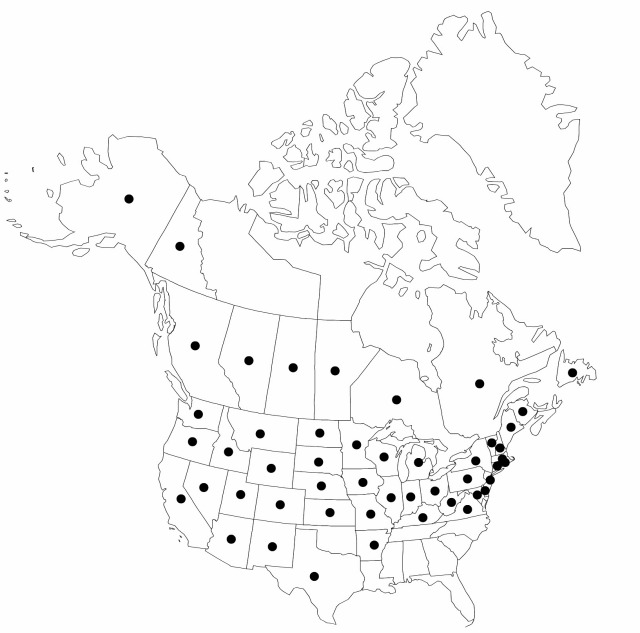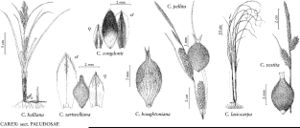Carex pellita
Sp. Pl. 4(1): 302. 1805.
Plants colonial; rhizomes long-creeping. Culms lateral, trigonous, 15–100 cm, smooth or slightly scabrous-angled. Leaves: basal sheaths reddish purple, usually fibrillose, bladeless, apex of inner band glabrous; ligules (1.2–)2–12 mm; blades green, flat or M-shaped except at base and tip, midvein of blades and proximal bracts forming sharply pointed keel, (2–)2.2–4.5(–6) mm wide, tip not prolonged, glabrous. Inflorescences 5–30 cm; peduncles of terminal spikes (0.8–)2–9 cm; proximal 1–3(–4) spikes pistillate, ascending; distal spikes erect; terminal 1–3 spikes staminate. Pistillate scales lanceolate to ovate, apex acute to acuminate-awned, glabrous or scabrous-margined apically. Perigynia ascending, broadly ovoid, 2.4–5.2 × 1.7–2.8 mm, densely pubescent, obscuring cellular details and veination; beak (0.6–)0.8–1.6 mm, firm, bidentulate, teeth straight, 0.4–0.8 mm. 2n = 78.
Phenology: Fruiting May–Aug.
Habitat: Wet to dry meadows, marshes, stream banks, lakeshores, open carrs and woodlands, low dunes, ditches, and other usually moist, successional habitats, especially in regions of calcareous soils
Elevation: 0–2900 m
Distribution

Alta., B.C., Man., N.B., Nfld. and Labr. (Nfld.), Ont., Que., Sask., Yukon, Alaska, Ariz., Ark., Calif., Colo., Conn., Del., Idaho, Ill., Ind., Iowa, Kans., Ky., Maine, Md., Mass., Mich., Minn., Mo., Mont., Nebr., Nev., N.H., N.J., N.Mex., N.Y., N.Dak., Ohio, Oreg., Pa., R.I., S.Dak., Tex., Utah, Vt., Va., Wash., W.Va., Wis., Wyo., Mexico.
Discussion
Carex pellita is abundant and variable in much of its range and a common plant of roadside ditches and other early successional or disturbed habitats. It is sometimes subsumed under C. lasiocarpa, as var. latifolia (Boeckeler) Gilly, but it is distinct in the field and has a quite different biology and distribution. However, slender and depauperate individuals can be difficult to distinguish in the herbarium.
The name Carex lanuginosa has been used for this species in many floras, but the type of this name is C. lasiocarpa.
Carex pellita hybridizes occasionally with C. hyalinolepis (= C. ×subimpressa) and rarely with C. lacustris, C. trichocarpa (= C. ×caesariensis, A. A. Reznicek and P. M. Catling 1985), and C. utriculata.
